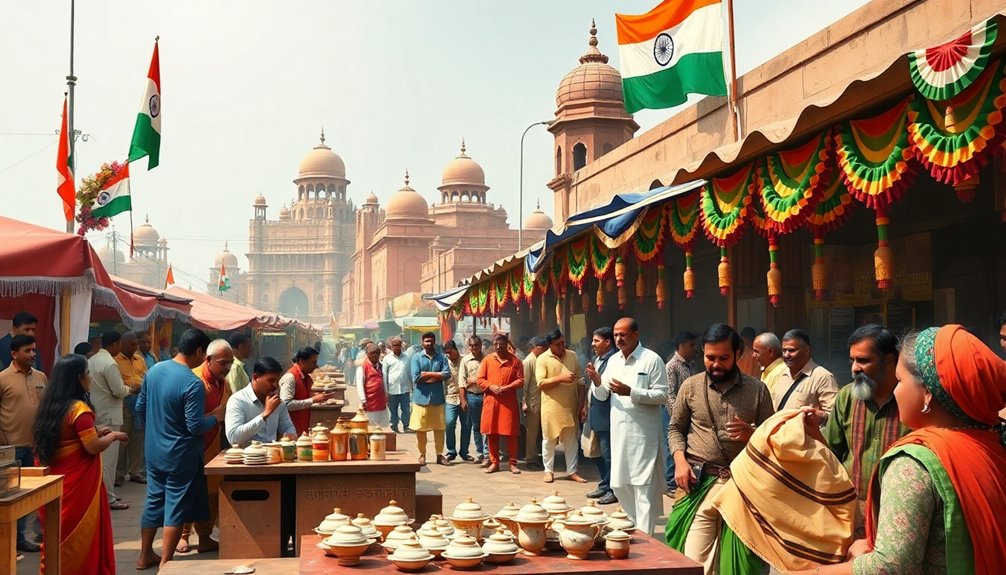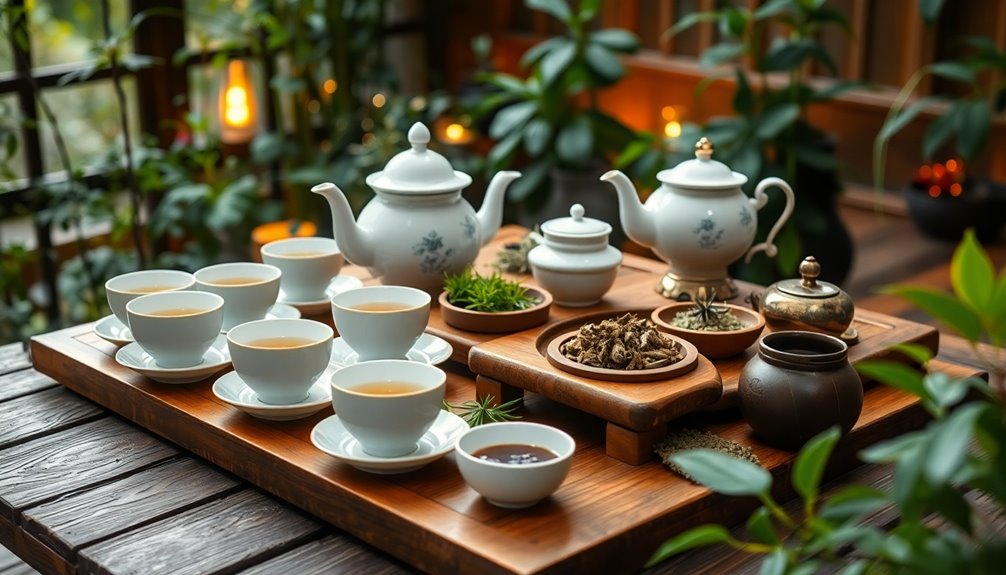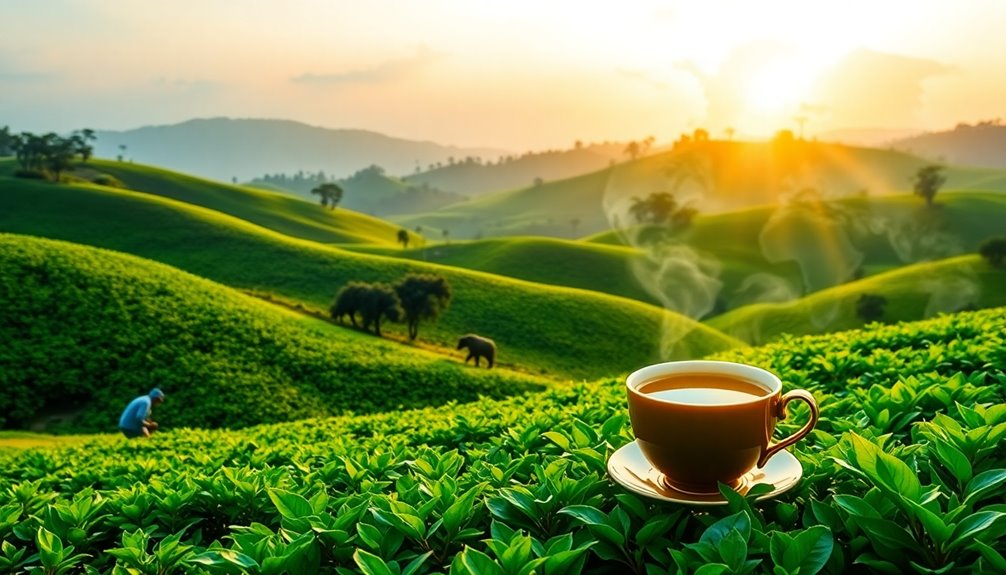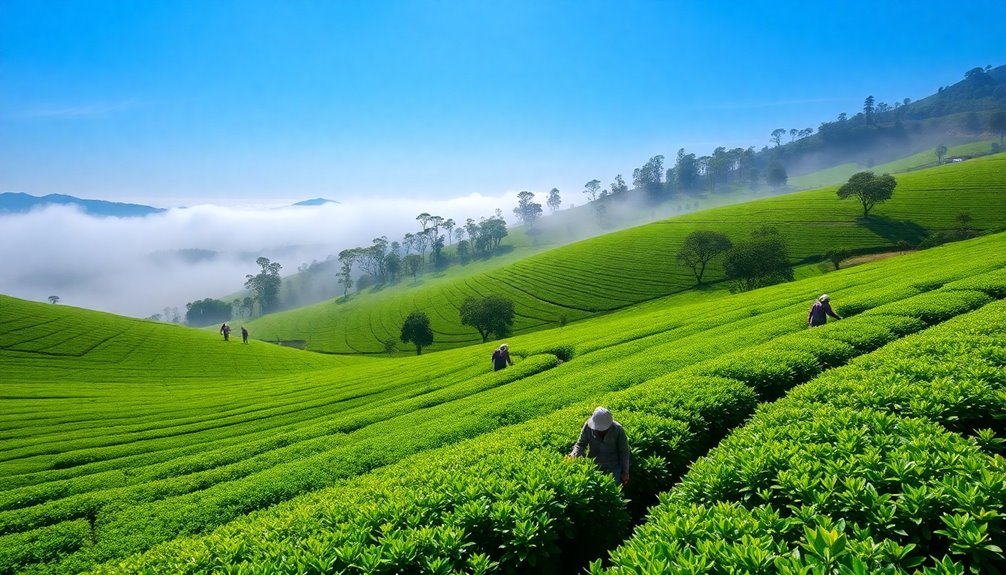Tea wasn't just a drink in India's independence movement; it was a powerful symbol of resistance and unity! Here's how it played a role:
- Protests: Tea gatherings became places to discuss freedom, swapping British tea for local brews.
- Cultural Pride: Slogans like "Tea is 100% Swadeshi" encouraged supporting local tea.
- Community Bonding: Refusing British tea connected everyone in their fight for self-reliance.
Tea stirred excitement and togetherness, making it a beloved part of India's journey to freedom. Isn't that interesting? Stick around, and you'll uncover even more fascinating details about tea's impact!
Key Takeaways
- Tea gatherings served as crucial platforms for discussing independence, fostering unity among freedom fighters and local communities.
- The slogan "Tea is 100% Swadeshi" promoted local tea consumption, symbolizing resistance against British colonialism and encouraging economic independence.
- Renouncing British tea and opting for herbal alternatives became a political statement reflecting commitment to self-reliance and Gandhi's values.
- Public outrage over poor working conditions of tea laborers intensified protests, highlighting the exploitation faced by workers under colonial rule.
- Post-independence, tea advertisements reclaimed cultural identity, reinforcing tea's role as a unifying symbol of national pride and resilience.
Introduction
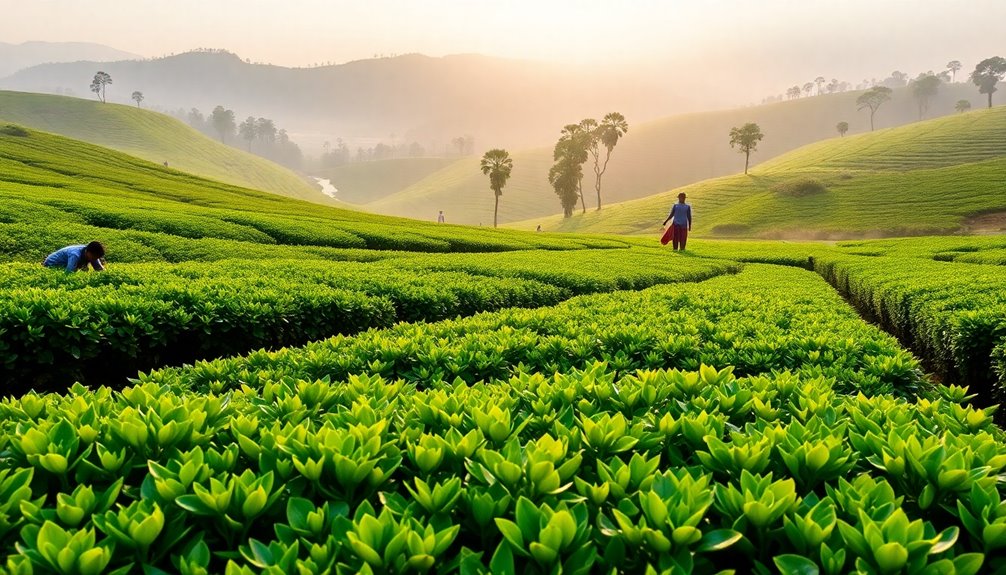
Tea's significance in India's independence movement goes beyond mere beverage consumption; it embodies a complex narrative of resistance and identity. Picture yourself sipping a warm cup of tea, feeling connected to a rich history.
During the British colonial era, tea became more than just a drink. The British East India Company started large-scale tea production in Assam in the 1820s, which led to many local protests against unfair practices.
- The workers on tea plantations faced tough conditions.
- This struggle turned into a symbol of British imperialism.
As the years passed, leaders like Mahatma Gandhi took a stand, criticizing British tea cultivation and encouraging people to boycott British tea. They wanted everyone to celebrate local tea instead.
The catchy slogan "Tea is 100% Swadeshi" emerged, highlighting cultural pride and economic independence.
Tea gatherings became important spaces for communities to unite, organize, and support the independence movement. These events strengthened bonds among friends and family, making everyone feel part of something special.
Tea's Role in Protests

Symbolizing resistance and unity, tea became a vital element in the protests against British rule in India. People gathered over cups of tea to discuss their hopes and dreams for freedom. The slogan "Tea is 100% Swadeshi" inspired many to embrace local tea instead of British brands. This shift was part of a broader movement led by Mahatma Gandhi, who encouraged everyone to renounce British goods as a peaceful way to resist colonial oppression.
The harsh conditions faced by tea plantation workers fueled public protests, sparking outrage against the exploitative British system. Many participants even swapped their beloved tea for herbal brews, showcasing their commitment to independence. Just like the Boston Tea Party in 1773, Indian protests used tea to symbolize the fight against unfair rule.
Tea gatherings became important meeting spots for communities, where people shared stories, ideas, and strategies for action. These warm gatherings helped strengthen bonds and encourage collective action. With every cup, they fueled the spirit of revolution, proving that even a simple drink could unite a nation. Additionally, the concept of collective creativity in movements like this reflects how ordinary practices can inspire significant social change.
Tea as a Unifying Symbol
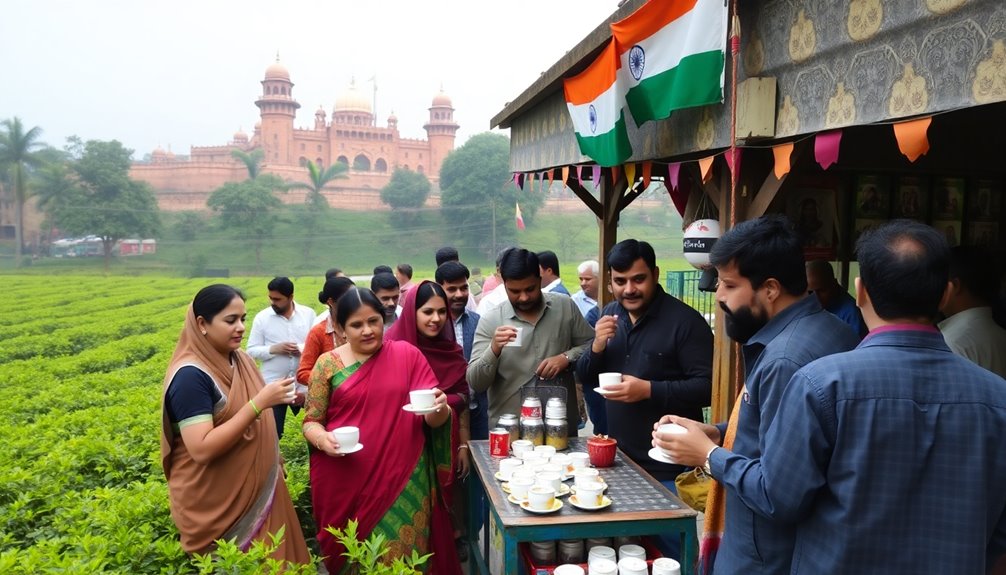
Amidst the struggle for independence, tea emerged as a powerful unifying symbol that brought people together across diverse backgrounds. You might be surprised to learn that tea became a symbol of self-reliance for many Indians. By promoting the slogan "Tea is 100% Swadeshi," nationalists encouraged everyone to enjoy Indian tea instead of British brands. This little cup of joy became a patriotic drink, sparking a sense of pride in the Indian tea industry.
Tea gatherings turned into exciting meetings where freedom fighters exchanged ideas and planned their next moves. Picture friends sipping tea, discussing dreams of Indian independence, and bonding over shared hopes. Mahatma Gandhi even highlighted tea's importance, urging people to be cautious about consuming British goods.
After independence, tea advertisements featured a beautiful dark-skinned woman, reclaiming cultural identity and showing India's resilience. This representation reminded everyone that tea wasn't just a drink; it was a symbol of unity and strength.
Satyagrahi Cha's Symbolic Importance
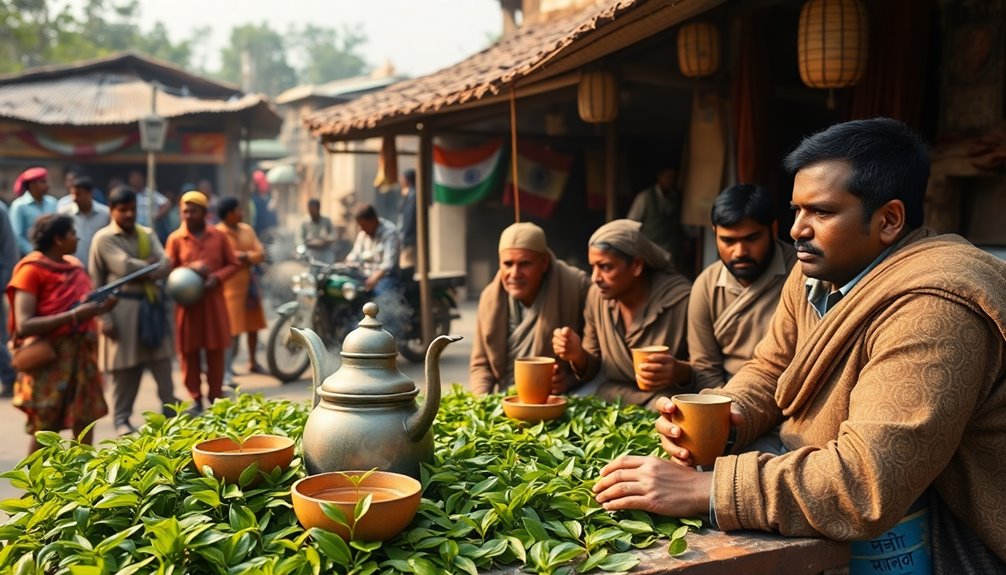
In the heart of the Satyagraha movement led by Mahatma Gandhi, the choice to renounce tea became a powerful act of defiance against British colonial rule. This wasn't just about saying no to tea; it was a way to show that the Satyagrahis believed in self-reliance and independence.
By swapping traditional tea for herbal brews, they embraced new, local flavors, proving their commitment to Gandhi's values of simplicity and self-control.
Here are some key points on the symbolic importance of Satyagrahi Cha:
- Resisting British Goods: Refusing tea consumption highlighted a stand against British products, making a strong political statement.
- Community Bonding: Satyagrahis often gathered to discuss tea alternatives, strengthening friendships and creating a united front against colonialism.
- Cultural Significance: This act became part of a larger narrative of national identity, showing how everyday choices matter in the fight for freedom.
Colonial Exploitation of Tea Labor
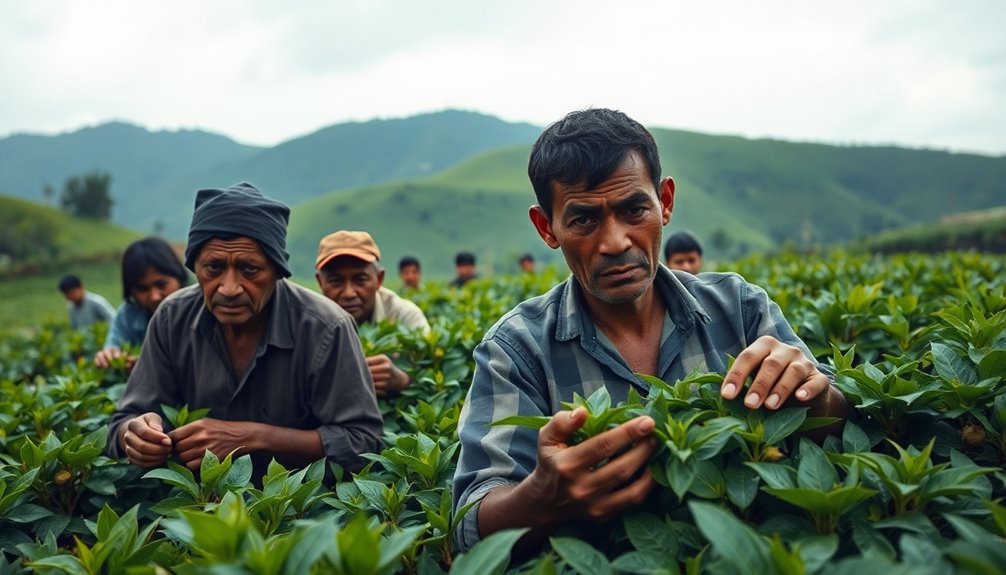
Colonial exploitation of tea labor in India reveals a troubling narrative of economic manipulation and human suffering. When the British East India Company began large-scale tea production in Assam during the 1820s, it changed everything for local farmers.
They transformed from self-sufficient growers into tea workers dependent on market demands. Many laborers, called coolies, faced harsh working conditions, especially women who often found themselves in low-paid jobs with long hours.
- Excessive Work: British landlords pushed tea workers to work harder for less money.
- Worker Rights: There was little to no respect for the rights of these workers.
- Unrest: This exploitation led to anger and resistance among local populations.
- Gender Issues: Women made up over half of the workforce but were sidelined in leadership roles.
Practical Applications
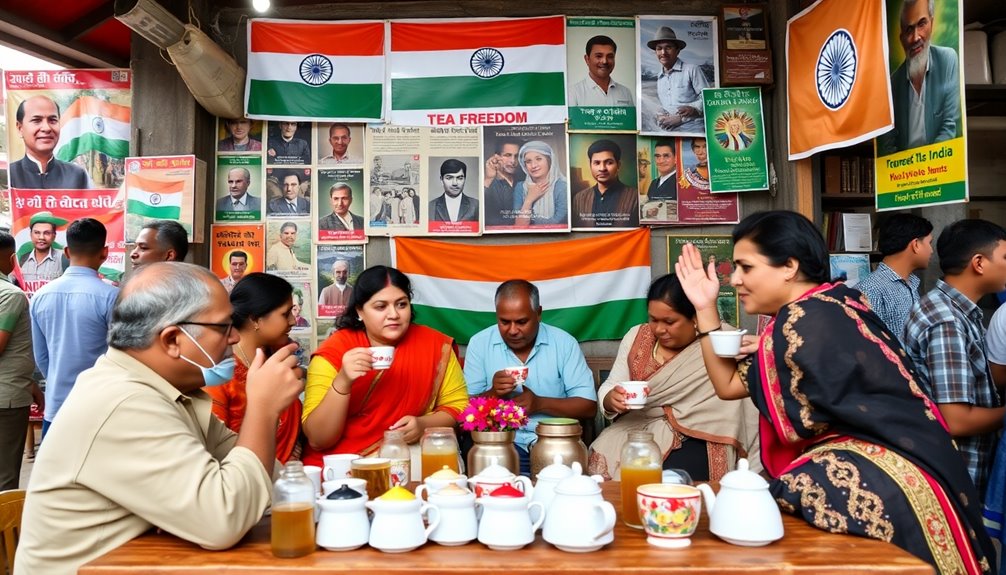
Tea serves not just as a beverage but as a powerful symbol of resistance and national identity in India's struggle for independence. You mightn't realize, but sipping tea was a way to stand up against British rule!
The tea industry in India became a big part of this journey, transforming from a colonial product to something uniquely Indian.
Here are some practical applications you can think about:
- Promoting Local Tea: When you enjoy tea from Indian tea plantations, you're supporting local farmers and celebrating Indian culture.
- Herbal Brews: Inspired by Mahatma Gandhi, you can try herbal teas as a healthy alternative, which also shows your pride in Indian traditions.
- Community Gatherings: Hosting tea parties can help you connect with family and friends, just like activists did during the independence movement. It's a fun way to share stories and strengthen bonds!
Frequently Asked Questions
What Was the Role of Tea in the British Rule Over India?
Tea's production under British rule transformed India's economy. You see how plantations exploited local labor, shifting subsistence farming to cash crops. This not only fueled British profits but also altered Indian social practices around tea consumption.
How Did Tea Change History in India?
Tea changed history in India by altering agricultural practices and labor dynamics, fostering community ties, and shaping national identity. It became a symbol of self-reliance, sparking resistance against colonial rule and uniting people toward common goals.
Why Is India Called a Country of Tea?
You call India a country of tea because it's deeply woven into daily life, culture, and social rituals. With vast production and consumption, tea represents hospitality, identity, and a rich heritage shared by millions.
Did Indians Drink Chai Before the British?
Yes, you're right. Indians did drink chai long before the British arrived. Indigenous tribes brewed wild tea for its health benefits, and by the late 1600s, people in cities enjoyed it with spices and sugar.
Conclusion
In conclusion, tea isn't just a tasty drink; it played a big role in India's fight for independence! It brought people together during protests, helped share ideas, and showed how powerful unity can be. Satyagrahi Cha became a symbol of strength and courage, reminding everyone of the struggle against unfair treatment. So, the next time you sip your tea, remember its amazing story and how it helped shape a nation's future. Cheers to tea and its rich history!

